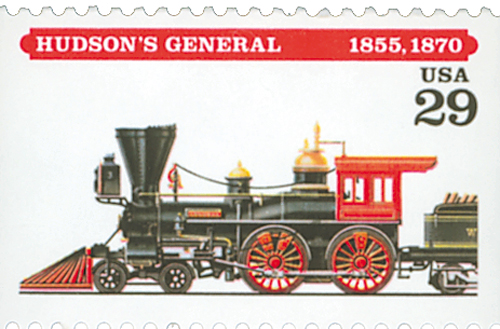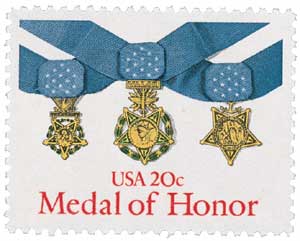
# 4902645 - 1994 Locomotives - Hudson's General Proofcard
Often called the ultimate philatelic issue, the Fleetwood Proofcard is a distinctive commemorative with an elegantly embossed surface. Each Proofcard bears an original work of art complementing the theme of the stamp and created exclusively for Fleetwood by a leading American artist. Proofcards are often collected on their own, but would also make a beautiful addition to your existing stamp or cover collection.
The Great Locomotive Chase

On April 12, 1862, a group of Union sympathizers stole a Confederate train, leading to a daring eight-hour chase.
Railroads played a major role during the Civil War, transporting troops and keeping them supplied. Although both sides used railroads, the South was at a distinct disadvantage because it had less track and far fewer locomotives available.
Supplies produced for the Confederate Army in the south were transported north by the Western & Atlantic rail line, often through Chattanooga, Tennessee. Union sympathizer James Andrews developed a plan to take Chattanooga, destroy the railroad tracks, and cut off the supply line.

Designed by William Hudson, the Confederate locomotive General was built in 1855 for the Western and Atlantic Railroad. The General left Atlanta, Georgia at 4:00 a.m. on the first anniversary of the attack on Fort Sumter. Andrews and 23 men (later referred to as Andrews’ Raiders) quietly boarded the train a few stops later. When the train stopped in Big Shanty, conductor William Fuller and his crew disembarked for breakfast. In a daring daylight raid, Andrews and his raiders stole the train and headed north – tearing up railroad ties and cutting telegraph wires as they went.

Fuller and his crew chased the hijacked train on foot for two miles. At the next northern station, they jumped aboard a platform handcar to continue the chase. Fuller commandeered two different engines in his pursuit of The General before taking the southbound The Texas at the Adairsville station. The chase was on – with Fuller pursuing at top speed – and The Texas in reverse.
Andrews dropped crossties on the tracks and let three boxcars loose – setting one on fire – in attempts to slow The Texas. Each time, Fuller’s men pushed the cars aside and continued the chase. South of Calhoun, Fuller spotted a young telegraph operator, pulled him aboard the train, and quickly wrote a message warning the Confederate general in Chattanooga of the approaching danger. The telegraph operator jumped off the train to telegraph the message.

After an 87-mile chase that lasted nearly eight hours, The General ran out of fuel and Andrews and his men were captured. Andrews was hung and buried unceremoniously in an unmarked grave. The first Medals of Honor of the war were given to some of Andrews’ men for their bravery.

After the war, The General was repaired and continued to serve on the Western and Atlantic Railroad. It remained in service until 1891 and would have been destroyed if not for E. Warren Clark, a photographer who suggested it be restored for display at the World’s Columbian Exposition. Over the next century, The General appeared at various expos and World’s Fairs before retiring at its current home in Chattanooga, Tennessee. The General’s story was also immortalized in a 1926 film starring Buster Keaton.
Click here to watch part of Keaton’s film, The General.
Often called the ultimate philatelic issue, the Fleetwood Proofcard is a distinctive commemorative with an elegantly embossed surface. Each Proofcard bears an original work of art complementing the theme of the stamp and created exclusively for Fleetwood by a leading American artist. Proofcards are often collected on their own, but would also make a beautiful addition to your existing stamp or cover collection.
The Great Locomotive Chase

On April 12, 1862, a group of Union sympathizers stole a Confederate train, leading to a daring eight-hour chase.
Railroads played a major role during the Civil War, transporting troops and keeping them supplied. Although both sides used railroads, the South was at a distinct disadvantage because it had less track and far fewer locomotives available.
Supplies produced for the Confederate Army in the south were transported north by the Western & Atlantic rail line, often through Chattanooga, Tennessee. Union sympathizer James Andrews developed a plan to take Chattanooga, destroy the railroad tracks, and cut off the supply line.

Designed by William Hudson, the Confederate locomotive General was built in 1855 for the Western and Atlantic Railroad. The General left Atlanta, Georgia at 4:00 a.m. on the first anniversary of the attack on Fort Sumter. Andrews and 23 men (later referred to as Andrews’ Raiders) quietly boarded the train a few stops later. When the train stopped in Big Shanty, conductor William Fuller and his crew disembarked for breakfast. In a daring daylight raid, Andrews and his raiders stole the train and headed north – tearing up railroad ties and cutting telegraph wires as they went.

Fuller and his crew chased the hijacked train on foot for two miles. At the next northern station, they jumped aboard a platform handcar to continue the chase. Fuller commandeered two different engines in his pursuit of The General before taking the southbound The Texas at the Adairsville station. The chase was on – with Fuller pursuing at top speed – and The Texas in reverse.
Andrews dropped crossties on the tracks and let three boxcars loose – setting one on fire – in attempts to slow The Texas. Each time, Fuller’s men pushed the cars aside and continued the chase. South of Calhoun, Fuller spotted a young telegraph operator, pulled him aboard the train, and quickly wrote a message warning the Confederate general in Chattanooga of the approaching danger. The telegraph operator jumped off the train to telegraph the message.

After an 87-mile chase that lasted nearly eight hours, The General ran out of fuel and Andrews and his men were captured. Andrews was hung and buried unceremoniously in an unmarked grave. The first Medals of Honor of the war were given to some of Andrews’ men for their bravery.

After the war, The General was repaired and continued to serve on the Western and Atlantic Railroad. It remained in service until 1891 and would have been destroyed if not for E. Warren Clark, a photographer who suggested it be restored for display at the World’s Columbian Exposition. Over the next century, The General appeared at various expos and World’s Fairs before retiring at its current home in Chattanooga, Tennessee. The General’s story was also immortalized in a 1926 film starring Buster Keaton.
Click here to watch part of Keaton’s film, The General.







